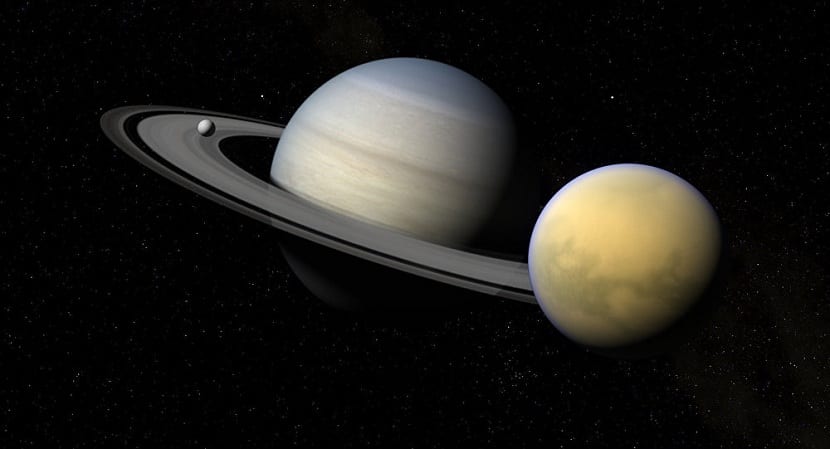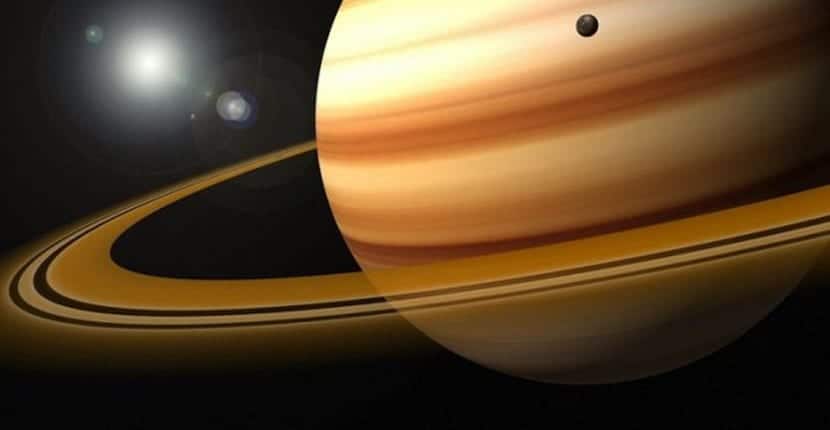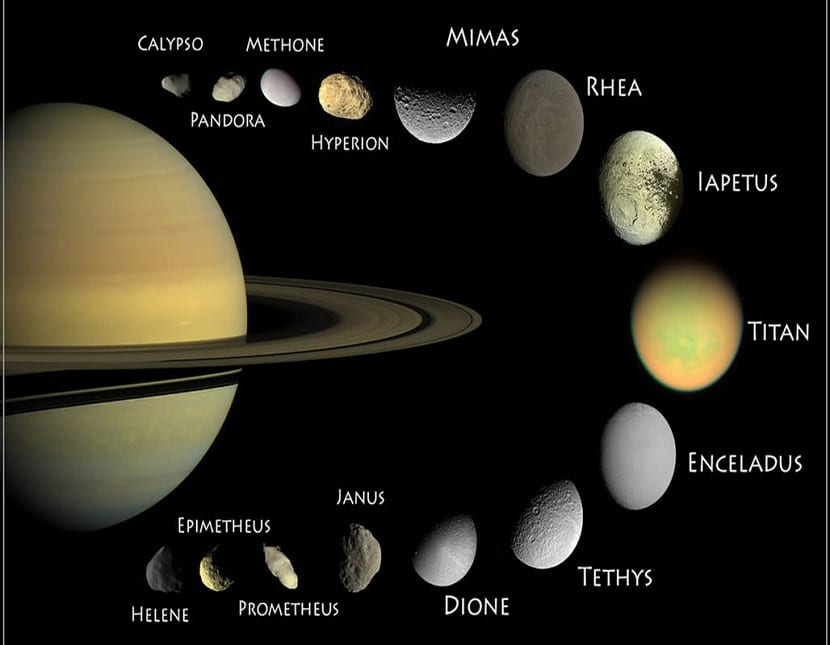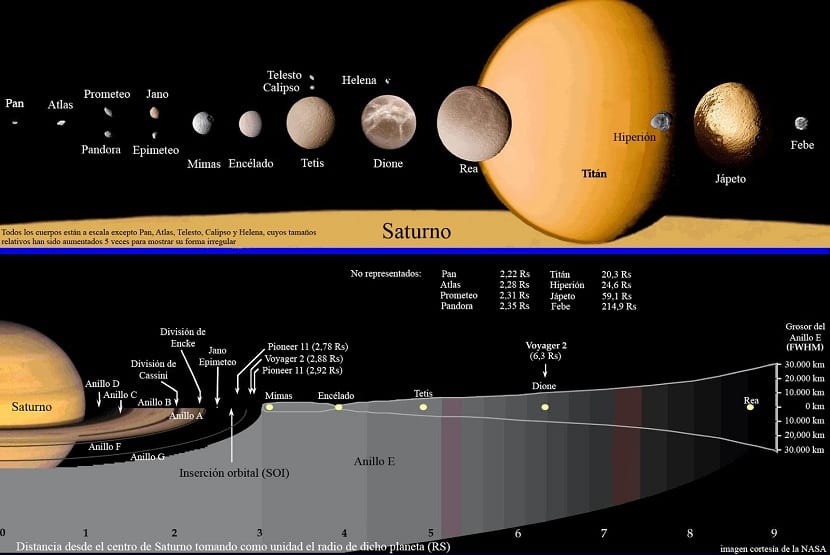
Each planet that makes up the Solar system it has one or more natural satellites that orbit around it. Satellites also have essential characteristics that make them different from other matter in the universe. In this case, we are going to talk about moons of saturn. There are more than 50 natural satellites orbiting this planet and yet they are divided into many groups, making hardly anyone know everything about Saturn's moons.
What are the most important moons on this planet and what are their characteristics? In this article we are going to detail all this in depth.
Saturn and its characteristics

We remember that Saturn It is the sex planet of the Solar System in terms of proximity to the Sun. It is positioned between the planets Jupiter and Uranus. It is the second largest planet in the Solar System. It has an equatorial diameter of 120 kilometers.
As for its morphology, it is a bit squashed by the poles. This squashing is due to the fact that its rotation speed is quite fast. Ring belts are visible from Earth. It is the planet that has the most asteroids orbiting around it. Given its composition of gases and its high amounts of helium and hydrogen, it belongs to the group of gas giants. Out of curiosity, its name comes from the Roman god Saturn.
Moons of saturn

Now that we have remembered a bit the characteristics of the planet Saturn, we are going to analyze everything about its moons. Currently, it is known to have 62 moons. These are the moons that, so far, have been confirmed by science. All the satellites you have have different shapes, surfaces, and origins. Scientists think that most of Saturn's moons were entered and captured by the planet as soon as they entered the planet's gravitational field.
That a planet has asteroids orbiting around it is nothing more than one of the actions of gravity. The larger the planet in size, the greater the force of gravity that attracts and can accommodate a greater number of asteroids orbiting the planet. We are talking about large material. Our planet only has one satellite orbiting us, but it does have thousands of rocky fragments that are also attracted by our gravitational field.
The most important moon of Saturn is called Titan. Surely you've heard it before in your life. It is the most important because it is the largest in the Saturn system. In addition, it is the second largest satellite in the entire Solar System after Ganymede (it belongs to one of the satellites of the planet Jupiter). Titan tends to be very important because it is the only celestial body where there are stable liquid deposits.
The rest of the moons of Saturn are divided into different groups, depending on their orbital and physical characteristics.
Groups of satellites

We are going to differentiate the main groups into which the different satellites of the planet Saturn are divided. This set of satellites is known as the Saturnine system and they are divided according to their main characteristics. Let's see what they are:
- Titan. As we have mentioned before, it is the most important satellite in terms of size. It is so large that it resembles that of a planet. It hardly exceeds the planet Mercury in size. Its diameter is 5.150 kilometers and it stands out for its atmosphere. It has a fairly dense atmosphere and is the only one that even has a record.
- Frozen medium satellites. These satellites are a standard size. As their name suggests, they are satellites covered by a layer of ice and different craters. These satellites were discovered before some of the expeditions carried out with telescopes. Some of the most important are: Tethys, Dione, Rhea, Hyperion and Iapetus.
- Ring satellites. Ring satellites are those that are orbiting within Saturn's rings.
- Shepherd satellites. It's about those who are outside the rings. Thanks to its orbit, it can help organize and moderate them, as if they were shepherds. Among the best known we have the F ring, Pandora and Prometheus.
- Trojan satellites. These satellites orbit at the same distance from Saturn as the larger satellites. They are usually about 60 degrees in front of or behind him. We find Helena and Pollux, among the most prominent.
- Coorbital satellites. These are those that have the same line that they orbit. This makes them satellites that act and move in such a way that they cannot collide with each other.
- Irregular satellites. It is a larger group of satellites, although it is quite far from Saturn. They are within your gravitational field.
- Minor lower satellites. They are all those who are between Mimas ice cream and Enceladus ice cream. Between these two icy satellite orbits are all the lower ones.
The most important moons of Saturn
Let's take a look at the most important moons of Saturn. Titan is the most important of all because it is larger and is made up of large amounts of hydrocarbons and hydrogen. This makes them achieve a more yellowish color. It is about 1.222.000 kilometers away from the planet and completes its journey around your planet every 16 days.
Let's move on to Rea. It is another of the most important satellites of Saturn. It is part of the medium ice creams. Its diameter is 1.530 kilometers and it is closer. It is thought that its center is formed by rock and with large amounts of water.
Lastly, Enceladus it is ranking sixth among the largest satellites of Saturn. It has a diameter of 500 kilometers. It is part of the group of frozen medium satellites. Its ice crust gives it the white color as it reflects almost 100% of the sunlight it receives.
I hope that with this information you can learn more about the moons of Saturn and have discovered more about this curious planet.